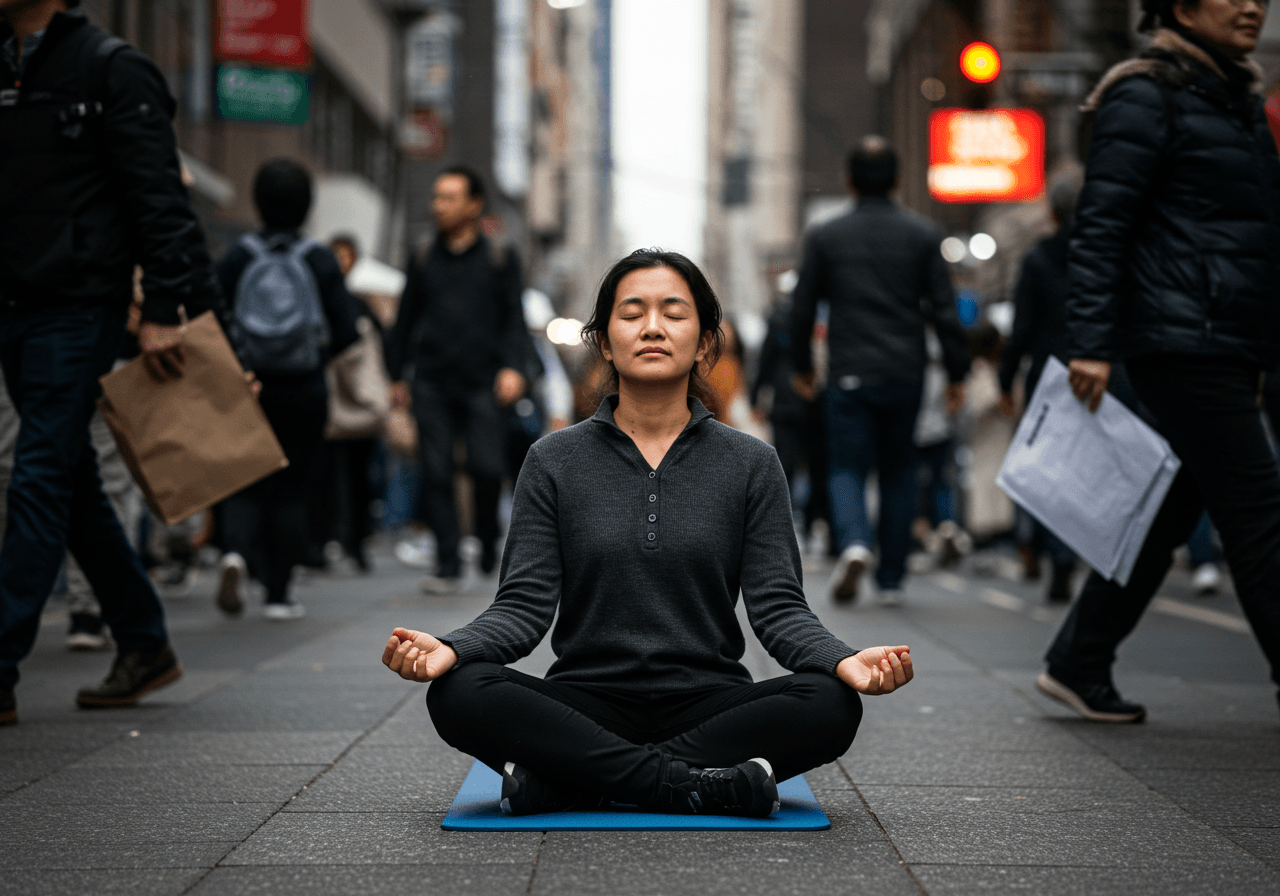Table of Contents
In today’s fast-paced world, stress is a common companion, often leaving you feeling overwhelmed and anxious.
Meditation offers a respite from this chaos, providing a tool to find peace and effective stress reduction.
Regular meditation practice can lead to a significant reduction in stress levels and enhance your sense of well-being. These benefits make meditation a valuable practice in managing the demands of modern life.

Getting started with meditation doesn’t require hours of dedication or complex techniques. Even just 10 minutes a day can make a meaningful difference.
Through simple practices, you can access a sense of calm and clarity, helping you navigate the stresses of daily life.
Whether you’re a beginner or have some experience, meditation can easily fit into your routine, offering a practical way to improve your mental health.
As you explore meditation, you’ll discover various techniques designed to help you manage stress more effectively.
From mindfulness meditation to quick one-minute practices, there’s a method that can suit your lifestyle. This blog post will guide you through incorporating these techniques into your day, helping you find calm amidst the busyness.
Key Takeaways
- Meditation significantly reduces stress and enhances well-being.
- Simple meditation practices fit easily into daily routines.
- Various techniques cater to different lifestyles for stress management.
Understanding Stress and Its Impact on Your Life

Stress is a natural response that can significantly affect your mental health and overall well-being. By comprehending the science behind stress and identifying your stress triggers, you can work toward effective stress management.
The Science of Stress
The body’s response to stress begins in the brain, specifically the amygdala, which perceives threats and activates the “fight-or-flight” response. This involves the release of hormones like adrenaline and cortisol, heightening your alertness and energy levels.
Stress can sometimes be beneficial, providing motivation or heightened awareness. However, prolonged stress may lead to anxiety and affect your physical and mental health. Understanding the physiological processes can empower you to manage stress more effectively.
Recognizing Stress Triggers
Identifying stressors in your life is crucial for effective stress management.
Common triggers include work pressure, financial difficulties, and relationship conflicts. Recognizing these stressors allows you to develop strategies to minimize their impact.
Evaluate your daily routine, noting situations that consistently cause tension or anxiety. Keeping a stress diary can be beneficial, allowing you to pinpoint patterns.
By understanding your unique triggers, you gain the ability to anticipate stressful situations, providing a foundation for improved mental health and overall well-being.
Basics of Meditation for Beginners

Meditation offers a soothing pathway to inner peace, especially for those new to its practice. Grasping the fundamentals is crucial to successfully making meditation a regular part of your daily routine.
Defining Meditation and Mindfulness
Meditation is a practice aimed at achieving a state of deep relaxation and heightened awareness. It’s often intertwined with mindfulness, which involves being present in the moment without judgment.
Various styles exist, including guided meditation, breath-focused meditation, and mindful observation. Each technique has its unique approach but shares the goal of cultivating a more peaceful mental state. It’s about grounding yourself in the now and observing your thoughts without attachment.
Setting Realistic Meditation Goals
Establishing achievable goals is essential when starting your meditation journey.
Begin with just a few minutes each day, gradually increasing as you become more comfortable. Consistency is more critical than duration, helping to create a sustainable habit.
Start by identifying what you hope to gain—be it stress relief, improved concentration, or emotional balance.
Set small, realistic targets and track your progress. Consider asking yourself: What can I commit to daily without feeling overwhelmed? This helps in staying motivated and creating a long-term practice beloved by millions worldwide.
Incorporating Meditation into Your Daily Routine

Integrating meditation into your daily activities can help alleviate stress and improve focus. To make meditation a consistent part of your life, effectively find time in your schedule and create a suitable environment.
Finding Time for Meditation
Identifying the right moments for meditation requires examining your daily schedule.
Start by incorporating brief meditation sessions into existing routines, perhaps during your morning or lunch break. A mindful morning routine could include five minutes of meditation to start your day with clarity and purpose.
Consider quick meditation techniques for busy days, such as focusing on your breath for a few minutes or using guided meditations available online. A digital detox is another way to create time, freeing up moments usually spent on screens.
Allocating these minutes may seem small, but they gradually lead to significant improvements in stress management. Flexibility is key; if mornings don’t work, try meditating before bed.
Creating a Conducive Environment
Setting up a space for meditation helps establish regular practice.
Choose a location where you feel relaxed and undisturbed. It doesn’t need to be elaborate; a quiet corner with a cushion or chair works well. Ambient lighting and soothing scents like lavender can enhance this space.
Eliminate distractions by silencing electronic devices, reinforcing a brief digital detox during your session. Another method is to keep this space tidy and personal, perhaps adding elements that comfort and inspire you, like a photo, plant, or meaningful object.
A stable environment not only encourages daily meditation habits but also acts as a visual reminder of your commitment to self-care.
Specific Meditation Techniques for Stress Relief

Meditation can ease stress through various techniques, each targeting different emotional and physical aspects of stress. This section examines focused breathing, body scanning, and guided meditations to help reduce stress and enhance well-being.
Breathing Techniques for Relaxation
Breathing techniques are essential for stress relief.
Mindful Breathing involves focusing on deep, slow breaths to help quiet the mind. Inhale deeply through your nose, hold for a moment, and exhale slowly through your mouth.
Box Breathing follows a simple rhythm: inhale for four counts, hold for four, exhale for four, and pause for four. This systematic approach helps in stabilizing your mood by engaging your parasympathetic nervous system.
Alternate Nostril Breathing is another technique, often used in yoga. It involves inhaling and exhaling through one nostril while closing the other, promoting balance and clarity in your mind. These simple methods become powerful tools in managing daily stress.
Body Scan Meditation
Body scan meditation focuses on your physical sensations, helping to release tension.
Begin by lying down in a comfortable position with closed eyes. Starting from your toes, gradually move your attention up to your head.
As you concentrate on each part, notice any sensations or tension, and consciously release it. This method encourages mindfulness of your body at present, creating a pathway to relaxation.
Developing this mindfulness can assist in reducing stress by easing physical and mental tension. Practicing regularly can build awareness and recognition of stress patterns in your body, allowing timely interventions.
Guided Meditation Explained
Guided meditation is a straightforward way to help manage stress through structured guidance.
Often delivered through recordings or apps, these meditations typically use a calming voice to lead you through mental exercises.
Such exercises may include visualizations and affirmations, which engage your imagination and help refocus your mind away from stressors.
Guided meditations can include themes like relaxation, peace, or self-compassion, tailored to suit personal goals.
You can access these resources in various formats, whether you prefer calming narratives, music, or even nature sounds to accompany the voice. These meditations provide a tangible starting point for incorporating meditation into your routine.
Advanced Mindfulness Practices
Incorporating advanced mindfulness techniques can enhance your stress reduction efforts. Mindful listening and walking are two practices that deepen your connection with yourself and the world around you.
Mastering Mindful Listening
Mindful listening involves fully engaging with the sounds and conversations around you.
Focus on hearing rather than just listening. This requires attention to both verbal and non-verbal cues.
Start by choosing a quiet environment.
Notice the tones, pauses, and emotions behind the words you hear. Avoid interrupting or planning your response while the other person speaks.
This practice helps in reducing stress by fostering deeper connections and emotional comprehension.
A simple practice is the five senses meditation. Close your eyes and pay attention to different sounds. Note how each makes you feel and what thoughts might arise.
Over time, this enhances self-awareness and empathy, helping you react mindfully to stressors.
Engaging in Mindful Walking
Mindful walking, or walking meditation, is about making each step an intentional and present act.
Begin by selecting a quiet path to minimize distractions.
As you walk, concentrate on the feeling of your feet touching the ground. Notice the rhythm of your breath and how it synchronizes with your steps. Let your senses absorb the surroundings: the scent of the air, the feeling of the breeze, the sights around you.
You can enhance this by practicing the five senses meditation during your walk. Acknowledge the environment through your senses, fully immersing in the moment.
This technique not only aids in stress reduction but also sharpens concentration and promotes emotional balance.
The Role of Meditation in Enhancing Focus and Productivity
Meditation is a valuable practice that cultivates mental clarity and boosts productivity. By integrating meditation into your daily routine, you can experience heightened focus and an improved ability to manage tasks efficiently.
The Link Between Meditation and Productivity
Meditation and mindfulness practices can significantly increase your productivity.
By fostering a calmer mind, meditation enables you to respond to daily challenges with greater thoughtfulness, reducing impulsive reactions.
Meditation helps in lowering stress, which directly impacts productivity by enabling clearer thinking and better decision-making under pressure.
Improved emotional resilience developed through meditation also contributes to maintaining a steady workflow even during challenging situations. When stressors are minimized, energy levels remain stable, allowing you to work more efficiently and effectively.
Meditation as a Tool for Better Focus
Practicing meditation encourages mental clarity and enhanced concentration.
By training your mind to stay on task, meditation helps minimize distractions and wandering thoughts.
Regular meditation sessions can increase your attention span, allowing you to focus more deeply on tasks at hand.
Meditation strengthens cognitive control, resulting in improved focus and the ability to manage complex information.
Incorporating mindfulness techniques can sharpen your focus over time. By being present in the moment, you become better equipped to concentrate on tasks, leading to more effective and productive work sessions.
Cultivating Positive Attitudes with Meditation
Meditation can foster positive attitudes in your daily life by promoting techniques that emphasize loving-kindness, gratitude, and visualization. These practices help shift your mental focus from stress and negativity to compassion and appreciation.
Embracing Loving-Kindness and Gratitude
Loving-kindness meditation involves cultivating feelings of compassion towards yourself and others.
You can begin by finding a quiet space and gently closing your eyes. Focus on sending thoughts of love and well-being, first to yourself, then extending these feelings to others, including loved ones and even those you may find challenging.
Gratitude meditation focuses on appreciating what you have.
Start by reflecting on things in your life you are thankful for. List them mentally or write them down. This exercise boosts emotional well-being and helps foster a sense of contentment.
Visualization for a Positive Outlook
Visualization practices can shape a more positive mindset.
This involves picturing a scenario where you feel truly happy and fulfilled. Focus on the details, such as sights, sounds, and emotions you experience in this imagined space.
Regular practice of visualization can reinforce a positive outlook by training your mind to expect and experience positive narratives.
By vividly imagining success or happiness, you can cultivate resilience and motivation, even during challenging times.
Lifestyle Changes for Sustained Stress Management
Embracing lasting lifestyle changes can greatly enhance your ability to manage stress. Through mindful practices and an attitude of acceptance, you can foster calmness and improve well-being.
Adoption of a Mindful Lifestyle
Incorporating mindfulness into your daily routine can lead to significant stress relief.
Regular mindfulness meditation trains you to focus on the present, which can decrease levels of anxiety.
Practicing deep breathing exercises or engaging in mantra meditation helps clear your mind, enhancing your sense of calmness.
Make time for daily meditation sessions, even if just a few minutes. Embrace mindful eating by paying attention to your meals without distractions.
Such practices cultivate awareness, reducing stress and improving mental clarity.
Acceptance and Letting Go
Learning to accept circumstances beyond your control prevents unnecessary anxiety. By focusing on acceptance, you release tension and foster a mindset that embraces change.
Letting go of perfectionism and unrealistic expectations promotes inner peace.
Using affirmations or mantras aids in reinforcing positive thoughts.
Consider writing down worries, then consciously deciding which issues to release. This process refocuses energy towards matters you can influence, contributing to a more balanced mental state.
Frequently Asked Questions
Meditation offers a powerful tool for stress reduction through various techniques and mindfulness practices.
By incorporating daily sessions, you can experience significant relief from stress, enhance mental clarity, and improve overall well-being.
What are the most effective meditation techniques for stress reduction?
Techniques such as mindfulness meditation, deep breathing, and body scan meditations are effective for reducing stress.
Mindfulness involves focusing on the present moment and observing thoughts without judgment.
Deep breathing engages the relaxation response, lowering stress levels.
Body scan meditation promotes relaxation by increasing awareness of bodily sensations.
How long should you meditate daily to experience a decrease in stress levels?
Even short daily sessions of 10 to 20 minutes can lead to noticeable stress reduction.
Consistency is crucial, so aim to carve out a specific time each day for your practice.
Over time, you may gradually lengthen your sessions as you become more comfortable with the practice.
Can meditation be used as a tool for managing acute stress in high-pressure environments?
Yes, meditation can be an effective tool for managing acute stress in demanding situations.
Techniques like mindfulness practices and rapid deep breathing exercises can quickly help you regain composure and clarity.
These methods shift your focus and calm your mind, making it easier to cope with high-pressure scenarios.
What is the role of mindfulness in reducing stress and enhancing relaxation?
Mindfulness plays a critical role in stress reduction by fostering a non-reactive awareness of your experiences.
This approach helps you understand and manage your reactions to stressors, cultivating a sense of calm.
In doing so, mindfulness not only reduces stress but also enhances relaxation and emotional regulation.
Are there guided meditations available that specifically target stress relief?
There are numerous guided meditations specifically designed for stress relief.
Many are available through mobile apps, websites, and online platforms.
These guided sessions often include calming instructions and soothing audio, allowing you to focus solely on relaxation without needing to manage the process yourself.
How does regular meditation practice contribute to overall mental health and stress management?
Regular meditation practice enhances mental health by promoting emotional stability, greater self-awareness, and increased resilience.
By consistently practicing, you empower yourself to manage stress effectively, improve concentration, and boost your mood.
Integrating meditation into your routine fosters a healthier mental state and improved stress management abilities.
Ready to explore meditation further?
Here are some books to deepen your practice and understanding:
- “Wherever You Go, There You Are” by Jon Kabat-Zinn: A classic introduction to mindfulness meditation by one of the pioneers of Mindfulness-Based Stress Reduction (MBSR). Excellent for understanding the core principles.
- “Full Catastrophe Living: Using the Wisdom of Your Body and Mind to Face Stress, Pain, and Illness” by Jon Kabat-Zinn: A more comprehensive guide to MBSR, offering detailed practices and insights into how mindfulness can help manage stress, pain, and illness.
- “Mindfulness for Beginners” by Jon Kabat-Zinn: A more concise and practical guide for those new to mindfulness meditation, including guided meditations.
- “The Mindful Way Through Depression: Freeing Yourself from Chronic Unhappiness” by Mark Williams, John Teasdale, Zindel Segal, and Jon Kabat-Zinn: Explores how mindfulness can be used to treat depression and prevent relapse.
- “10% Happier” by Dan Harris: A more personal and relatable account of one person’s journey to mindfulness, good for readers who are skeptical or new to the concept.
- “My Stroke of Insight” by Jill Bolte Taylor: A neuroscientist’s account of her own stroke and recovery, highlighting the power of mindfulness and the interconnectedness of mind and body.
- “Search Inside Yourself” by Chade-Meng Tan: Explores mindfulness and emotional intelligence in the context of the workplace.





10 thoughts on “Meditation for Stress Reduction: Unlocking Tranquility Amid Chaos”